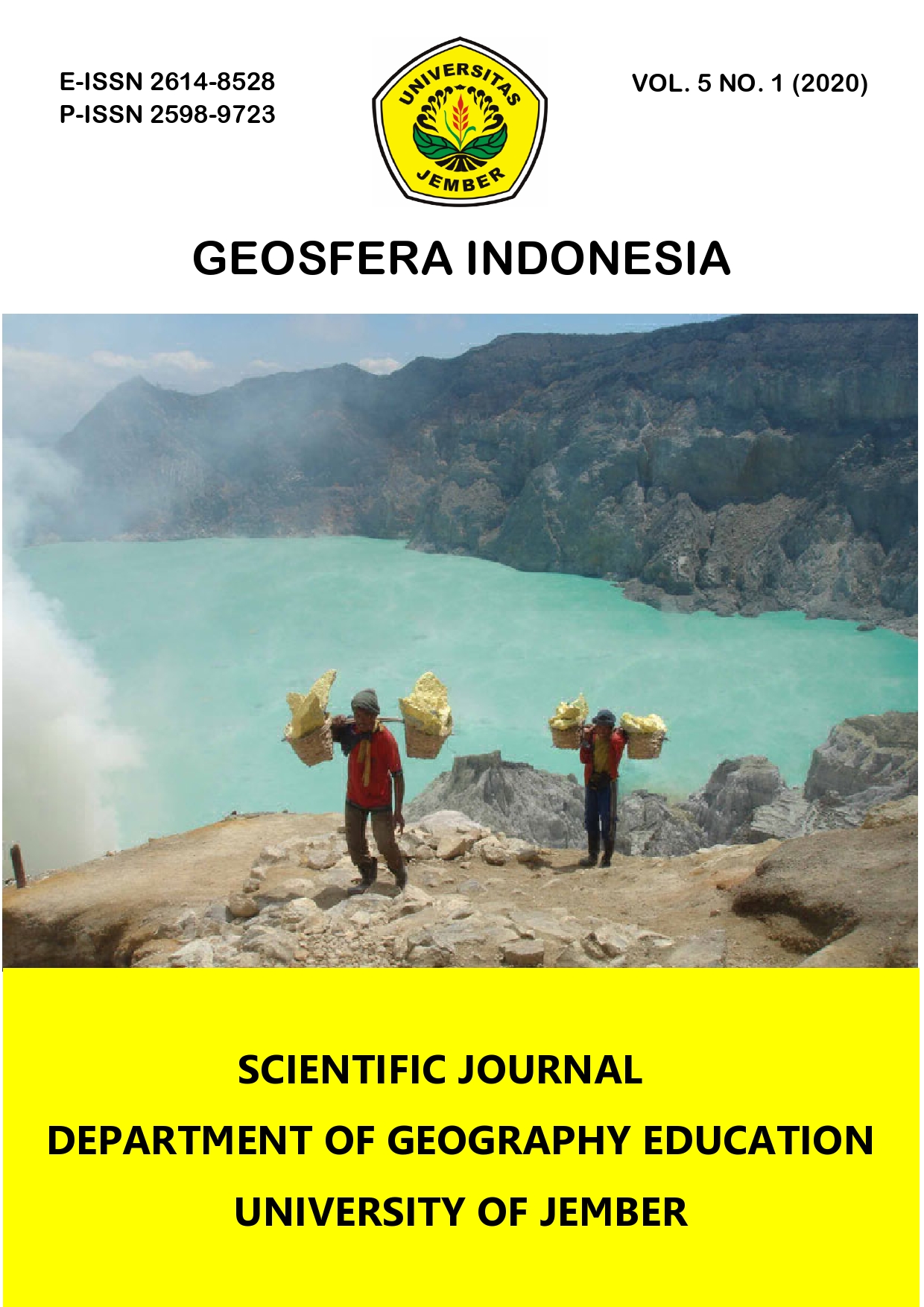The Application of Geographic Information System (GIS) and Remote Sensing in Quantifying Snow Cover and Precipitation in Kabul Basin
DOI:
https://doi.org/10.19184/geosi.v5i1.14896Abstract
Water Resources availability is very important to social and economic well-being of the people and has huge impacts on the socio-economic scenarios of a country. Precipitation and snow cover area assessment is some of the major inputs in hydrologic modelling and also for assessing and managing water resources in a basin. The change in the water availability in a basin has huge socio-economic impacts because of the water usage for food production, industries, and many others. The main aim of this study was to measure the snow cover area and precipitation from 2001 to 2015 in the Kabul basin. Moderate Resolution Image Spectroradiometer (MODIS) and Tropical Rainfall measuring Mission (TRMM) data were used to study snow cover area and precipitation respectively during 2001-2015. 8-day snow cover product for 15 years (January) was used to analyse the snow cover while monthly data of TRMM (3B43) were used to analyse the rainfall from 2001-2015. Different image processing techniques were applied on the data retrieved using GIS and Remote Sensing softwares. Initially, SCA was seen increasing, but during the last 3-4 years, it kept decreasing gradually. Rainfall was initially recorded as low, while later on, it was recorded high and reached the highest during 2010.
Keywords: MODIS; Snow Cover; TRMM; Precipitation; Kabul Basin; Remote Sensing
Copyright (c) 2020 Geosfera Indonesia Journal and Department of Geography Education, University of Jember

This work is licensed under a Creative Commons Attribution-Share A like 4.0 International License
Downloads
References
Atif, I., Mahboob, M. A., & Iqbal, J. (2015). Snow cover area change assessment in 2003 and 2013 using MODIS data of the Upper Indus Basin, Pakistan. Journal of Himalayan Earth Sciences, 48(2), 117-128.
Aziz, A. (2014). Rainfall-Runoff Modeling of the Trans-Boundary Kabul River Basin Using Integrated Flood Analysis System (IFAS). Pakistan Journal of Meteorology, 10(20).
Beato Bergua, S., Poblete Piedrabuena, M. Ã., & Marino Alfonso, J. L. (2019). Snow avalanches, land use changes, and atmospheric warming in landscape dynamics of the atlantic mid-mountains (cantabrian range, NW spain). Applied Geography, 107, 38-50. doi:10.1016/j.apgeog.2019.04.007
Biemans, H., Siderius, C., Lutz, A. F., Nepal, S., Ahmad, B., Hassan, T., . . . Immerzeel, W. W. (2019). Importance of snow and glacier meltwater for agriculture on the indo-gangetic plain. Nature Sustainability, 2(7), 594-601. doi:10.1038/s41893-019-0305-3
Daly, S. F., Vuyovich, C. M., Deeb, E. J., Newman, S. D., Baldwin, T. B., & Gagnon, J. J. (2012). Assessment of the snow conditions in the major watersheds of Afghanistan using multispectral and passive microwave remote sensing. Hydrological Processes, 26(17), 2631-2642.
Ershadi, A., Khiabani, H., & Lorup, J. K. (2005). Applications of remote sensing, GIS and river basin modelling in integrated water resource management of Kabul River Basin. In ICID 21st European Regional Conference.
Hall, D. K., Riggs, G. A., & Salomonson, V. V. (1995). Development of methods for mapping global snow cover using moderate resolution imaging spectroradiometer data. Remote sensing of Environment, 54(2), 127-140.
Hall, D. K., Riggs, G. A., & Salomonson, V. V. (2001). Mapping Global Snow Cover using Moderate Resolution Imaging Spectroradiometer (MODIS) Data. Glaciological Data, 33.
Il Jeong, D., & Sushama, L. (2018). Rain-on-snow events over north america based on two canadian regional climate models. Climate Dynamics, 50(1-2), 303-316. doi:10.1007/s00382-017-3609-x
Kumar, S., Srivastava, P. K., & Snehmani. (2018). Geospatial modelling and mapping of snow avalanche susceptibility. Journal of the Indian Society of Remote Sensing, 46(1), 109-119. doi:10.1007/s12524-017-0672-z
Kummerow, C., Barnes, W., Kozu, T., Shiue, J., & Simpson, J. (1998). The tropical rainfall measuring mission (TRMM) sensor package. Journal of atmospheric and oceanic technology, 15(3), 809-817.
Larson, K. M., Gutmann, E. D., Zavorotny, V. U., Braun, J. J., Williams, M. W., & Nievinski, F.G. (2009). Can we measure snow depth with GPS receivers?. Geophysical Research Letters, 36(17).
Lashkaripour, G. R., & Hussaini, S. A. (2008). Water resource management in Kabul river basin, eastern Afghanistan. The Environmentalist, 28(3), 253-260.
Miao, F., Wu, Y., Li, L., Liao, K., & Zhang, L. (2019). Risk assessment of snowmelt-induced landslides based on GIS and an effective snowmelt model. Natural Hazards, 97(3), 1151-1173. doi:10.1007/s11069-019-03693-2
Nakamura, K. (2019). Implementation and demonstration of a system for the forecasting of surface avalanche potential caused by snowfall from a cyclone. Journal of Disaster Research, 14(9), 1201-1226. doi:10.20965/jdr.2019.p1201
New, M., Todd, M., Hulme, M., & Jones, P. (2001). Precipitation measurements and trends in the twentieth century. International Journal of Climatology, 21(15), 1889-1922.
Plach, J., Pluer, W., Macrae, M., Kompanizare, M., McKague, K., Carlow, R., & Brunke, R. (2019). Agricultural edge-of-field phosphorus losses in ontario, canada: Importance of the nongrowing season in cold regions. Journal of Environmental Quality, 48(4), 813-821. doi:10.2134/jeq2018.11.0418
Pyankov, S. V., Shikhov, A. N., Kalinin, N. A., & Sviyazov, E. M. (2018). A GIS-based modeling of snow accumulation and melt processes in the votkinsk reservoir basin. Journal of Geographical Sciences, 28(2), 221-237. doi:10.1007/s11442-018-1469-x
Sayama, T., Ozawa, G., Kawakami, T., Nabesaka, S., & Fukami, K. (2012). Rainfall–runoff– inundation analysis of the 2010 Pakistan flood in the Kabul River basin. Hydrological Sciences Journal, 57(2), 298-312.
Vick, M. J. (2014). Steps towards an Afghanistan–Pakistan water-sharing agreement. International Journal of Water Resources Development, 30(2), 224-229.
Wu, Y., Ouyang, W., Hao, Z., Yang, B., & Wang, L. (2018). Snowmelt water drives higher soil erosion than rainfall water in a mid-high latitude upland watershed. Journal of Hydrology, 556, 438-448. doi:10.1016/j.jhydrol.2017.11.037
Zahid, M., & Rasul, G. (2011). Frequency of extreme temperature and precipitation events in Pakistan 1965–2009. Sci. Int.(Lahore), 23(4), 313-319.
Zhang, X., & Srinivasan, R. (2010). GIS-based spatial precipitation estimation using next generation radar and raingauge data. Environmental Modelling & Software, 25(12), 1781-1788.



